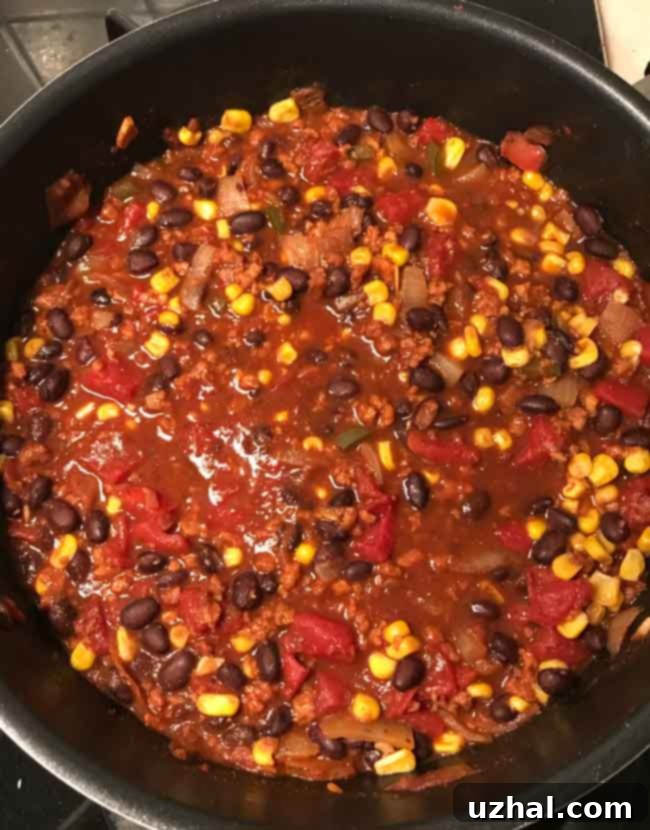Hearty & Flavorful Vegetarian Chili Recipe: A Versatile Plant-Based Favorite
For years, my beloved Tofu Chili has been a staple in our household, a comforting classic enjoyed by everyone. As tastes and culinary trends evolve, so does our approach to cooking. While tofu remains a fantastic option, the exciting variety of plant-based beef substitutes now available has opened up new possibilities for this cherished recipe. That’s why I’ve updated the name to “Vegetarian Chili,” reflecting its flexibility and inviting you to explore different protein choices beyond just tofu.
This recipe is designed to be incredibly adaptable, allowing you to personalize it to your taste and what you have on hand. Whether you’re a long-time vegetarian, looking to incorporate more plant-based meals into your diet, or simply craving a delicious and hearty bowl of chili, this recipe offers a robust foundation. It’s more than just a meal; it’s a canvas for your culinary creativity. Below, you’ll find detailed ingredient notes and preparation tips to guide you, but remember, the best chili is always the one you make your own.
Jump to Recipe

Creating a truly memorable pot of chili is a wonderfully personal journey. While I’ve provided a comprehensive guide to my favorite Vegetarian Chili, think of this recipe as a flexible template. Feel free to adjust the spices, swap out ingredients, or add your unique twist to make it perfectly suited to your palate. From the choice of protein to the level of heat and sweetness, every element can be customized to create your ideal chili experience.
Ingredient Deep Dive: Crafting Your Perfect Vegetarian Chili
The beauty of this vegetarian chili lies in its foundational ingredients and the versatility they offer. Let’s delve into each component, providing insights and suggestions to help you make the best chili possible.
Aromatics: Oil, Onion, and Garlic
- Vegetable Oil, Onion, and Garlic: These are the holy trinity of flavor starters for many savory dishes, and chili is no exception. A good quality vegetable oil (like canola or sunflower) provides the base. Sautéing the chopped onion until translucent unlocks its natural sweetness and depth. Minced garlic, added after the onion, brings a pungent aroma and rich flavor. Be careful not to burn the garlic; it should only cook for a minute or two until fragrant. For an extra kick, consider adding a fresh jalapeño (seeded and minced for less heat, or with seeds for more spice) along with the onions and garlic, especially if you’re not using “Mexican Style” diced tomatoes, or simply crave more heat. Other peppers like serrano or poblano can also be fantastic additions for varying heat and flavor profiles.
The Protein Powerhouse: Tofu or Vegetarian Beef Crumbles
- Tofu: When using tofu, especially extra-firm or super-firm varieties, proper preparation is key. The goal is to remove as much moisture as possible to achieve a better texture. Pressing the tofu for at least 30 minutes (or even longer) using a tofu press or by wrapping it in paper towels and placing heavy objects on top can make a huge difference. For an even more “meaty” texture, try freezing and then thawing your tofu before pressing it; this creates more porous pockets that absorb flavors beautifully. Once pressed, crumble the tofu directly into the pot, allowing it to brown slightly and absorb the chili’s rich flavors.
- Vegetarian Beef Crumbles: The market for plant-based meat alternatives has exploded, offering excellent options for chili. Brands like Gardein, Beyond Meat, or Impossible Foods offer frozen or refrigerated crumbles that are incredibly convenient and mimic the texture of ground beef. You can often add these directly from the bag (if frozen) or thawed, eliminating the need for extensive pressing or draining. For this recipe, about 1 ½ cups of frozen crumbles usually suffices. They integrate seamlessly into the chili, providing a hearty, satisfying chew that even meat-eaters will appreciate. Experiment with different brands to find your favorite, as their flavor profiles can vary.
The Spice Palette: Cumin, Chili Powder, and Oregano
- Cumin: This spice is a non-negotiable for chili, offering an earthy, warm, and slightly pungent flavor that is quintessential to its character. I personally love cumin and use a generous tablespoon, but if you find its flavor too strong, feel free to reduce the amount. You can also lightly toast whole cumin seeds before grinding them for an even more intense and aromatic profile.
- Chili Powder: The term “chili powder” can be ambiguous. Some brands are blends of various spices (including cumin, oregano, garlic powder, and ground chili peppers), while others are simply pure ground dried chili peppers (like ancho or New Mexico chilies). Be sure to choose a quality chili powder blend (such as Gebhardt, as mentioned in the original recipe) and be mindful of its heat level. If you prefer a milder chili, opt for a mild blend. If you like heat, you can choose a spicier blend or supplement with cayenne pepper. Always check the label!
- Oregano: Mexican oregano tends to have more citrus and earthy notes, while Mediterranean oregano is often described as minty or peppery. Either works well in chili, but Mexican oregano is traditionally preferred for its authentic flavor profile in Tex-Mex dishes. A teaspoon adds a subtle herbaceous background that complements the other spices beautifully.
The Tomato Base: For Richness and Body
- Tomatoes: Any 14-ounce can of diced tomatoes will form a solid foundation for your chili. However, “Mexican Style” diced tomatoes often come pre-seasoned with a blend of peppers (like jalapeños or poblanos) and spices, adding an extra layer of built-in flavor and heat. If you use plain diced tomatoes, you have more control to add fresh or dried peppers to your liking with the onions and garlic. Fire-roasted diced tomatoes are another excellent choice, imparting a wonderful smoky depth that elevates the entire dish. Don’t drain the diced tomatoes; the liquid is essential for the chili’s consistency.
- Tomato Sauce: The half-cup of tomato sauce contributes to the chili’s smooth texture and concentrated tomato flavor, bridging the gap between the diced tomatoes and broth for a cohesive base.
- Cocoa Powder: A secret ingredient for many traditional chili recipes, unsweetened cocoa powder doesn’t make your chili taste like chocolate. Instead, it deepens the color and adds an incredible richness and complexity to the flavor profile, balancing the savory and spicy notes.
Sweetness and Flavor Balance
- Ketchup and Brown Sugar: This recipe leans slightly towards a sweet chili, which many find incredibly appealing as it balances the acidity of the tomatoes and the heat of the spices. Ketchup provides both sweetness and a tangy depth, while brown sugar offers a molasses-rich sweetness. If you prefer a less sweet chili, you have options: reduce or eliminate the brown sugar, and/or substitute some or all of the ketchup with a tablespoon or two of tomato paste. Tomato paste offers a concentrated umami flavor without the added sugar, thickening the chili slightly and adding a robust tomato essence.
The Liquid Foundation: Vegetable Broth
- Vegetable Broth: The 1 ½ cups of vegetable broth are crucial for simmering the chili and allowing the flavors to meld. To save money and control sodium levels, I often use 1 ½ teaspoons of Better Than Bouillon mixed with 1 ½ cups of hot water. This concentrated paste delivers excellent flavor. If you have canned or homemade vegetable broth on hand, that works perfectly too. Remember to taste your chili before adding extra salt, especially if using a salty broth like reconstituted Better Than Bouillon, which usually contains enough sodium that additional salt isn’t needed.
The Hearty Fillers: Beans and Beyond
- Beans: Beans are a cornerstone of any good chili, adding significant fiber, protein, and texture. While black beans are our family’s favorite for this recipe (ensure they are drained and rinsed to remove excess sodium and starches), feel free to use any kind of beans you prefer. Kidney beans, pinto beans, or even a mix of different beans would be delicious.
- Other Add-ins: Don’t limit yourself! A handful of fresh or frozen corn kernels can add a pop of sweetness and texture, while garbanzo beans (chickpeas) offer a different kind of creaminess. Experiment with what you love!
Achieving the Perfect Thickness
- Thickening the Chili: As seasoned chili makers know, chili typically starts off thinner and gradually thickens as it simmers and cools. This recipe is designed to reach a good consistency on its own. However, if after simmering, you find your chili isn’t quite thick enough for your liking, a few spoonfuls of Masa Harina (a finely ground corn flour, commonly used for tortillas, such as Maseca brand) can work wonders. Simply stir it in and continue to simmer for a few minutes; it will absorb excess liquid and create a richer texture. Alternatively, a cornstarch slurry (cornstarch mixed with a little cold water) can be used, but Masa Harina imparts a more authentic, subtly corn-flavored richness.
Recipe

Fuzz’s Vegetarian Chili (formerly Tofu Chili)
By Cookie Madness
Pin Recipe
10 mins
40 mins
50 mins
Entree
American
4
Ingredients
- 1 tablespoon vegetable oil
- 1 large onion chopped
- 3 cloves garlic minced
- 10 oz extra firm tofu or 1 ½ cups veg. beef crumbles (for tofu: frozen, thawed, drained, pressed dry; for crumbles: frozen or thawed)
- 1 tablespoon chili powder (like Gebhardt, adjust for heat preference)
- 1 tablespoon ground cumin (can reduce if preferred)
- 2 tablespoons ketchup (or tomato paste for less sweetness)
- 1 14.5-ounce can diced “Mexican Style” tomatoes, undrained (or any diced tomatoes, fire-roasted suggested)
- ½ cup tomato sauce
- 1 teaspoon unsweetened cocoa powder
- 1 ½ teaspoons brown sugar (optional, for sweetness; can reduce or omit)
- 1 teaspoon dried oregano
- 1 ½ cups vegetable broth (or reconstituted Better Than Bouillon)
- 1 15 oz can black beans, drained and rinsed (or kidney, pinto, garbanzo beans)
Instructions
-
In a large Dutch oven or a 3 ½ quart pot, heat the vegetable oil over medium heat. Add the chopped onion and sauté for about 3 minutes until it begins to soften and become translucent. Next, add the minced garlic and your chosen protein (either pressed and crumbled tofu or vegetarian beef crumbles). Sauté for another 2 minutes, stirring occasionally, until the garlic is fragrant and the protein starts to brown slightly.
-
Stir in the chili powder, ground cumin, ketchup (or tomato paste), undrained diced tomatoes, tomato sauce, brown sugar (if using), unsweetened cocoa powder, dried oregano, and vegetable broth. Bring the mixture to a gentle boil, then reduce the heat to low. Simmer uncovered for approximately 30 minutes, stirring occasionally. During this time, the chili will naturally begin to thicken as the liquids reduce and flavors meld.
-
For a deeper flavor, you can simmer the chili longer. After the initial 30 minutes, cover the pot and continue to simmer for an additional 30 minutes to an hour, or even longer on very low heat. This slow cooking allows the flavors to intensify. Just before serving, add the drained and rinsed black beans to the pot. Cook for another 5 minutes, or until the beans are thoroughly heated through. Taste and adjust seasonings as needed, adding salt or more chili powder if desired.
Notes
Tried this recipe?
Let us know how it was!
Serving Suggestions for Your Vegetarian Chili
A bowl of hot chili is wonderful on its own, but it truly shines with a variety of toppings and accompaniments. Get creative and set up a chili bar for your family or guests!
- Classic Toppings: Shredded cheese (dairy or plant-based cheddar/Monterey Jack), a dollop of sour cream (dairy or cashew-based vegan sour cream), fresh chopped cilantro, sliced green onions, and diced avocado or a scoop of guacamole. A squeeze of fresh lime juice can also brighten the flavors.
- Heat Boosters: A dash of your favorite hot sauce, extra fresh or pickled jalapeños, or a sprinkle of red pepper flakes for those who like it extra spicy.
- Hearty Sides: Serve alongside warm cornbread (a classic!), fluffy white or brown rice, or even quinoa for added protein. It’s also fantastic poured over a baked potato or sweet potato, transforming it into a complete and satisfying meal.
- Crunchy Elements: Crushed tortilla chips or corn chips add a satisfying crunch and can be great for dipping.
Storage and Make-Ahead Tips
Chili is one of those magical dishes that often tastes even better the next day, once the flavors have had more time to meld and deepen. This makes it an excellent candidate for meal prepping!
- Refrigeration: Leftover chili can be stored in an airtight container in the refrigerator for up to 3-4 days. It’s perfect for quick lunches or dinners throughout the week.
- Freezing: For longer storage, allow the chili to cool completely before transferring it to freezer-safe containers or heavy-duty freezer bags. It can be frozen for up to 3 months. Thaw overnight in the refrigerator before reheating.
- Reheating: Gently reheat chili on the stovetop over medium-low heat, stirring occasionally, until heated through. You can also microwave individual portions. If the chili has thickened too much in the fridge or freezer, add a splash of vegetable broth or water to reach your desired consistency while reheating.
The Benefits of Choosing Vegetarian Chili
Beyond its incredible taste and versatility, opting for a vegetarian chili offers numerous advantages:
- Healthier Option: Typically lower in saturated fat and cholesterol compared to meat-based chilis, while still being packed with protein and essential nutrients from beans, vegetables, and plant-based proteins.
- Rich in Fiber: Beans and vegetables are excellent sources of dietary fiber, which is crucial for digestive health, blood sugar control, and feeling full and satisfied.
- Environmentally Friendly: Choosing plant-based meals reduces your carbon footprint, requires less water and land resources, and is a sustainable choice for the planet.
- Cost-Effective: Plant-based proteins like tofu and beans are often more affordable than meat, making this a budget-friendly meal that doesn’t compromise on flavor or nutrition.
- Allergen-Friendly (adaptable): Easily made gluten-free (ensure broth and crumbles are certified GF) and can be adapted for various dietary needs, including vegan (by using vegan sour cream/cheese alternatives).
Customization Ideas for Your Unique Chili
Don’t stop at the basic recipe! Here are more ways to make this chili truly yours:
- Add More Vegetables: Diced bell peppers (any color), zucchini, mushrooms, or sweet potatoes can be added with the onions for extra nutrition and flavor.
- Spice It Up: Introduce a pinch of cayenne pepper, a diced habanero, or a spoonful of chipotle in adobo sauce for smokiness and heat. Smoked paprika (as mentioned in the original notes) is also an excellent addition for a mild, smoky depth.
- Different Beans: As noted, any bean works! Try cannellini beans for a creamier texture.
- Grain-Free/Low-Carb: Omit the beans and serve over cauliflower rice or spaghetti squash for a lower-carb option.
- Global Flavors: A dash of liquid smoke, a bay leaf during simmering, or even a spoonful of peanut butter (a surprising but effective thickener and flavor enhancer in some chilis) can introduce new dimensions.
Whether you’re making this Vegetarian Chili for a crowd, a quiet night in, or as part of your weekly meal prep, its robust flavors and wholesome ingredients are sure to satisfy. Embrace the versatility, experiment with your favorite add-ins, and enjoy a truly comforting and delicious bowl.
